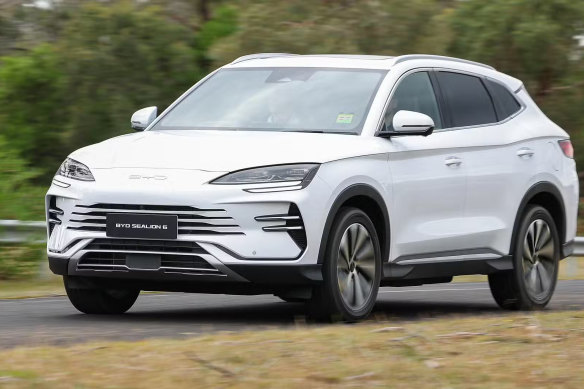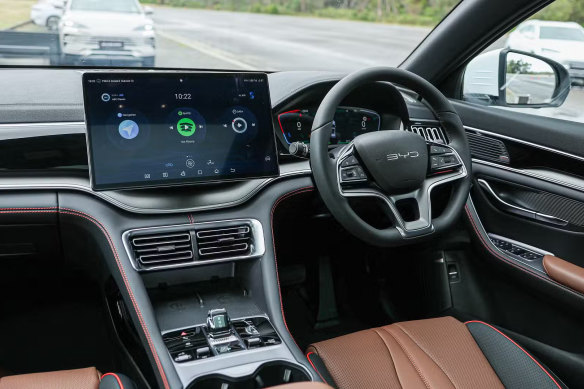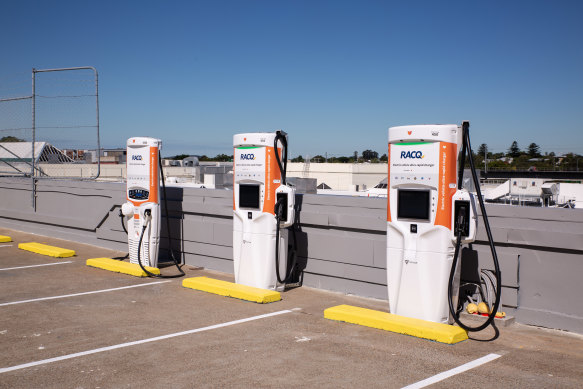This was published 3 months ago
Opinion
The EV haters have a point
David Swan
Technology editorWe’re at an awkward point for electric vehicles in Australia. Sales are slowing, in line with global trends, and buyers are increasingly opting for plug-in hybrids.
There’s a good reason for that.
A two-week trial of BYD’s latest plug-in hybrid, the Sealion 6, sums up why plug-in hybrids are the new flavour of the month and will likely continue to eat into EV sales over the coming months and years.

The BYD Sealion 6.Credit: Drive.com.au
EVs have been on Australian roads for years now, but the brutal reality is still that public charging infrastructure remains sub-par, particularly inland. For many drivers, plug-in hybrids, or PHEVs, ideally should represent the best of both worlds: an electric motor for zipping around the city combined with a more traditional petrol engine for longer road trips.
I decided to drive a model from Chinese manufacturer BYD from Melbourne to Sydney – with a four-month-old baby in tow – to test it out for myself.
There are an increasing number of BYDs on Australian roads, but mentioning the brand still garnered a “who?” or a “what?” from some people I spoke to over the past couple of weeks.
Carrying a slogan of “Build Your Dreams”, the Chinese manufacturer is about 20 years old but only entered the Australian market in 2022 through a partnership with local distributor EVDirect. It’s quickly become the second-largest electric vehicle brand in the country, behind Tesla, surpassing more than 25,000 in local sales. It has ambitions to double sales year-on-year for the next three years.
BYD has seemingly benefited from Tesla chief executive Elon Musk’s polarising behaviour, which has put off some potential buyers, as well as Tesla’s ongoing supply-chain issues that have slowed production.
The Chinese company had previously only offered all-electric vehicles in Australia, including the Dolphin and Seal, but the Sealion 6 – and a coming ute, the Shark – are its first local plug-in hybrids.
The Sealion 6 premium all-wheel-drive I tested retails for about $52,990 drive away. BYD started its first deliveries of the Sealion 6 to Australian consumers in June, and EVDirect chief executive David Smitherman said it had quickly become the company’s best-selling vehicle.

BYD Australia chief executive David Smitherman.Credit: AFR
“It’s clear that many Australian drivers are looking to a plug-in hybrid as their first foray into new energy vehicles,” he said. “BYD’s growth has been extraordinary, and we know the quality of the technology because of the interest from other brands within the automotive and consumer electronic space ... BYD wants to build a lasting legacy in Australia.”
BYD has its own proprietary plug-in hybrid system, which the company calls DM-i technology. The Sealion 6 drives as an EV with its electric powertrain, but its “fuel” can be electric or hybrid. Put simply, the car aims to operate as an EV in the first instance, and the petrol engine kicks in when you’re low on battery or driving on a motorway, for example.
The car itself is slick: a medium SUV that rivals more expensive peers such as the Tesla Model Y and Polestar 3 in terms of style, cabin comfort and technology.
The generous 15.6-inch touchscreen is a joy to use, as is the wireless Apple CarPlay/Android Auto and wireless charging upfront for your phone. The all-wheel-drive model also has a heads-up display that projects the car’s speed and other data onto the windscreen. Some might have apprehension about a car made in China – just as another buyer might have pause for buying a car associated with Elon Musk – but rest assured, the Sealion 6 is as sturdy and feels just as premium as its peers. And it’s really fun to drive.

The BYD Sealion 6 centre console.Credit: Drive.com.au
The vehicle boasts a staggering range of more than 1000 kilometres – made up of about 1000 kilometres from its petrol engine and about 80 kilometres from its electric battery – though from my testing, it’s likely to be a little less in the real world.
There were times during the two-week loan – especially with an often malcontent four-month-old baby in the back seat – when I was grateful to be in a hybrid rather than a pure-breed electric vehicle.
There are now about 3000 public charging stations dotted around Australia, including a mix of standard and fast chargers (less than 50kw), ultra-rapid chargers (350-475kw) and Tesla superchargers.
It’s a bit of a chicken-and-egg situation. EV adoption will inevitably pick up further once the infrastructure is adequate, and more chargers will be built once the demand is there – but either way, unfortunately, we’re still just not there yet.
Range anxiety – the term to describe the worry that EV drivers feel about their battery’s charge being enough for a journey – is real, and considering a Melbourne to Sydney jaunt generates range anxiety on steroids.
The search for the best route from my Melbourne house to Sydney along the Hume is intimidating. Superfast 350kw chargers are still few and far between, making planning the drive a far more involved and deliberate process than just hitting the road.
Many chargers also require new smartphone apps to download, such as the NRMA or Chargefox app, before you can start charging your car. It was a good thing I had Telstra reception all along the Hume – having no reception and, therefore, being unable to charge your car would, for some, be a version of our new tech hell.
Range anxiety – the term for the worry that EV drivers feel about their battery’s charge being enough for a journey – is real, and considering a Melbourne to Sydney jaunt generates range anxiety on steroids.
It’s simply not something that drivers of cars with combustion engines have had to deal with. Pretty much wherever we’re driving, we know that there’ll likely be a petrol station close enough.
What’s even more real is the anxiety of waiting 40 minutes – or perhaps longer if the chargers are all occupied – with a screaming baby for an EV to be recharged.
Those worries are gone with the Sealion 6, which meant I could get between the two cities with just one petrol refuel (10 minutes in Holbrook) and one EV top-up (half an hour in Jugiong).
The “granny charger” (I didn’t use that term given we were staying with my inlaws; I went with “trickle charger”) meant I could plug the Sealion 6 into a normal power point overnight and have the car fully charged in about nine hours. This is an ideal car for anyone in an apartment building or without a garage, given you charge the battery without a dedicated EV charger installed. The car also comes with an adapter that can power external electrical appliances such as a coffee machine.

Chargefox electric charging stations.Credit: AFR
There are some cons and trade-offs, of course. The electric motor is perfect for zipping around the city, but its range of 100 kilometres is relatively short. And in my view, the drive-away price of $53,000 represents great value, but that’s still a bit more expensive than some petrol medium SUVs in its class.
Plug-in hybrids are, of course, not the future, but they feel like the smartest option for many people right now. And certainly at least for the next few years until we can genuinely say Australia has the fast-charging infrastructure to adequately support long trips.
PHEVs are a sensible stepping stone for people who aren’t ready to make the leap to a full EV. I fit that bill, and I have a hunch most of Australia does, too.
It’s certainly what I’ll be leaning towards for our family’s next ride.
The Business Briefing newsletter delivers major stories, exclusive coverage and expert opinion. Sign up to get it every weekday morning.